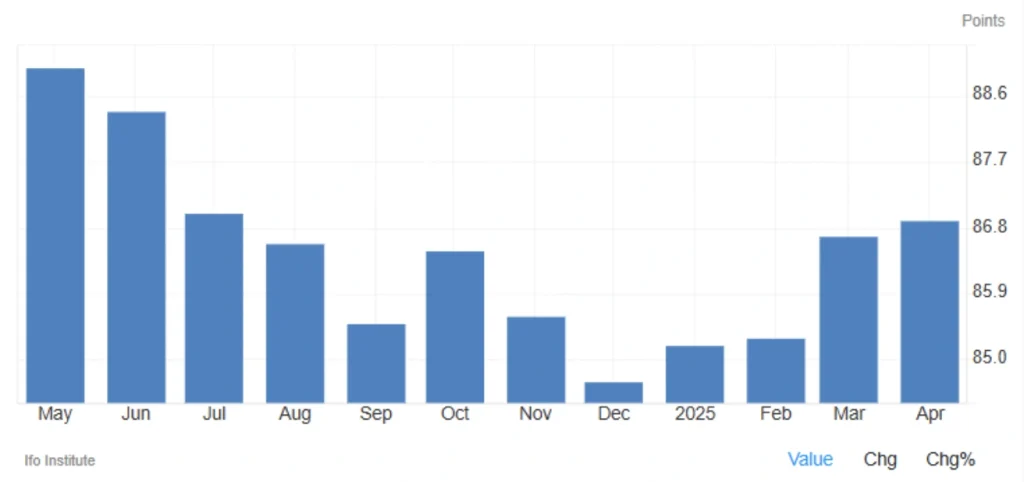
Germany’s Business Climate Index Hits Highest Level Since July
In April 2025, Germany’s Ifo Business Climate Index increased slightly to 86.9 points, marking the highest level since July 2024. This represents a modest rise from 86.7 points the previous month and defies earlier forecasts, which predicted a decrease. This positive outcome is largely attributed to government investment and supportive policies improving Germany’s business climate.
Key Driver: Increased Government Investment in Infrastructure and Defense
One of the key factors contributing to the improvement in business sentiment is the German government’s expansion of public spending, particularly in infrastructure, military, and business support sectors. These measures are designed to counteract external risks and stimulate domestic growth, especially in response to the ongoing US trade threats. This has had a positive impact on Germany’s business climate.
Breakdown of the Ifo Index Components in April
| Component | Current Value | Previous Value | Analysis |
|---|---|---|---|
| Current Assessment | 86.4 | 85.7 | Above expectations, with a noticeable improvement in businesses’ assessment of the current situation. |
| Expectations Index | 87.4 | 87.7 | Slight decline but still above market forecasts of 85. |
| Services | -0.8 | -1.1 | Mild improvement, approaching a neutral position. |
| Construction | -21.0 | -24.3 | Reduced pessimism compared to the previous month. |
| Manufacturing | -18.1 | -16.6 | Significant decline, indicating continued pressures in the industrial sector, affecting Germany’s business climate. |
What is the Ifo Index?
The Ifo Business Climate Index is one of the most important forward-looking indicators of the German economy. It is based on a survey of around 9,000 business leaders across various industries, including manufacturing, construction, services, and trade. The index is made up of two key components, which are essential to understanding Germany’s business climate:
- Current Assessment: Evaluates the current state of businesses.
- Expectations for the Next 6 Months: Measures future business expectations.
✅ Rising index values generally indicate improving business confidence and a positive outlook for economic growth.
Read More: What is the DXY Index?

Analysis: Germany at the Intersection of External Threats and Internal Support
Positive Signals:
- Increased public spending has helped stabilize the domestic market, maintaining a sense of economic stability and positively influencing Germany’s business climate.
- The better-than-expected performance of the current business environment suggests a degree of resilience in Germany’s economy.
Weaknesses:
- The declining future expectations and drop in manufacturing are concerning signs for the long-term outlook of Germany’s business climate.
- Trade wars, tariffs, and US policy remain ongoing sources of economic instability.
Conclusion: Germany Shows Signs of Gradual Recovery
The German economy has demonstrated some signs of gradual recovery in April 2025. However, for this positive trend to continue, structural challenges and external threats must be addressed to maintain Germany’s business climate. Germany’s ability to navigate these risks while maintaining domestic stability will be critical for its future economic prospects.
Share
Hot topics

Federal Reserve’s Challenges to Trump’s New Policies
As the Federal Reserve Open Market Committee (FOMC) prepares for its upcoming meeting, all eyes are on how the Fed will respond to Donald Trump’s latest economic policies. With the...
Read more




Submit comment
Your email address will not be published. Required fields are marked *